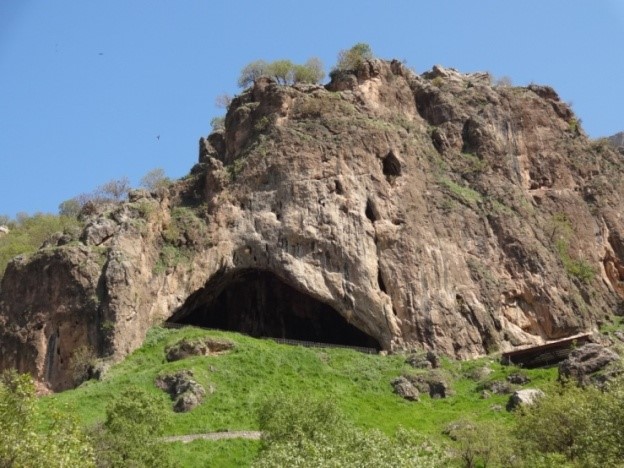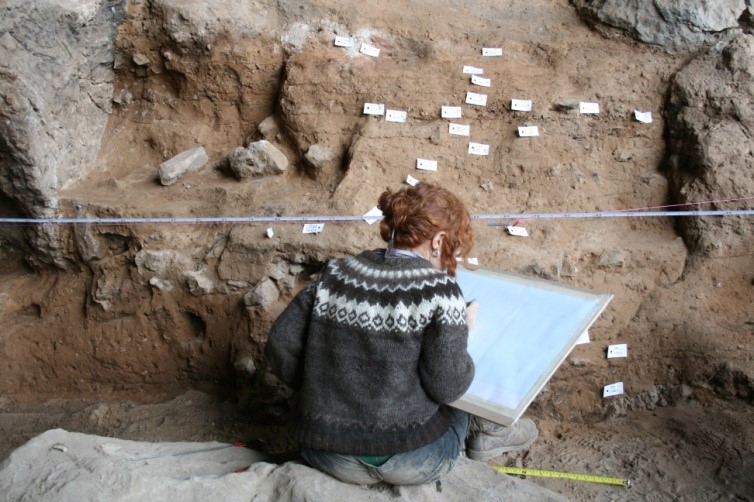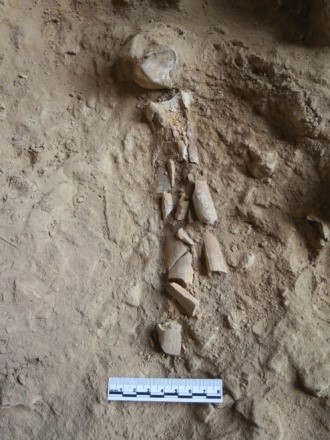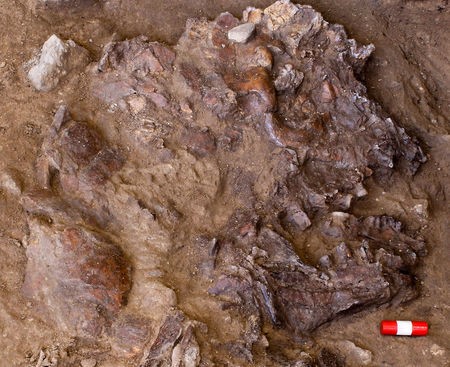

Shanidar cave viewed from the south (Photograph: Graeme Barker)
The Shanidar Cave Project
Following an invitation to Professor Graeme Barker from the Kurdistan Regional Government of Iraq, the Shanidar Cave Project was established as a collaboration between the University of Cambridge and the Kurdistan Directorate of Antiquities. Our excavations since 2015 have focused on the eastern edge of Solecki‘s 14 m-deep trench, where most of the Neanderthal remains were discovered. We have cleaned and recorded his trench walls down to 10 m and taken small samples of sediment for soil chemistry, pollen and ancient DNA, and for dating.
We have excavated a series of c.30 × 30 cm ‘sample columns’ down these sections to provide sediment for on-site flotation. We have excavated small trenches around the locations of his Shanidar 1, 3 and 5 Neanderthals at about 3-4 m depth, and at around 7-8 m depth where he found the cluster of individuals he designated Shanidar 4, 6, 8 and 9.

Edge of the Solecki trench being recorded after cleaning (Photograph: Graeme Barker)
The General Directorate of Antiquities and the Directorate of Antiquities (Soran Office) have given us permission to export archaeological materials on loan for specialist analyses: selected stone tools, fragments of animal and human bone, mollusc fragments, charcoal for vegetation reconstruction and radiocarbon dating, and a variety of sediment samples for pollen, sedimentological and geochemical analysis, OSL (optically stimulated luminescence) dating and micromorphological analysis. All other excavated sediment is processed in a system of flotation tanks to wash out carbonised materials and to wash the remaining residues, which after drying are screened and painstakingly searched for all archaeological materials, the aim being to retrieve everything larger than 2 mm.
Both Neanderthals and the modern humans (‘Baradostians’) who replaced them used the cave mainly as a seasonal hunting station, on the evidence of their small camp fires or hearths. The main species hunted by both was the extremely agile ibex, which we regularly see grazing in the Shanidar Cave Archaeological Reserve, hopping up what seem to be more or less vertical cliffs. They come into the cave to drink at a spring behind the excavation, along with predators like hyenas and wolves. Both Neanderthals and modern humans also hunted small game including tortoises, caught fish in the Greater Zab River near the cave, and collected snails and a variety of plant foods.
An entirely unexpected bonus has been the discovery of in situ skeletal remains, which are exceptionally rare in Neanderthal archaeology. In 2015 and 2016 we found some articulated leg bones from Solecki’s Shanidar 5 Neanderthal. Preliminary indications from our radiocarbon and OSL dates are that it dates to around 45,000-50,000 years ago.

Articulated leg bones belonging to Solecki's Shanidar 5 Neanderthal. Scale 8 cm. (Photograph: Graeme Barker)
In 2016 we found further Neanderthal bones near where Solecki found the 'Flower Burial'. When we excavated these bones in 2018 and 2019, we found the crushed skull of an adult Neanderthal overlying parts of his/her (we don't know yet!) arms and upper torso. The bones were very soft and were consolidated with chemicals before lifting.

The complete but heavily crushed skull during excavation. The teeth and jaws can be seen towards the bottom right of the photo. Scale: 3cm (Photograph: Graeme Barker)
The bones were in a shallow scoop and were partly covered by rocks that appear to have been definitely placed. The burial dates to around 70,000-75,000 years ago. There are occupation layers above and to the side of it, so we have a unique opportunity to use precision excavation techniques to investigate whether Neanderthals lived and buried their dead here at the same time, or did they alternate between using the cave as a place for the living and as a place for the dead? Whatever we discover about the relationship between the living and the dead in this extraordinary site should contribute importantly to the big debates about how similar or different Neanderthal behaviour – and imagination - were to our own.

The cleaned section of the Deep Sounding in 2018 showing the location of the new Neanderthal skeletal remains and, above and to the side of them, occupation layers. The 'Flower Burial' was found immediately in front of our excavation. Scales: 1 m. (Photograph: Graeme Barker)
Media Coverage
https://www.nature.com/news/archaeologists-ousted-by-isis-return-to-ancient-iraqi-cave-1.18487
https://www.sciencemag.org/news/2019/01/new-remains-discovered-site-famous-neanderthal-flower-burial
https://www.rudaw.net/english/kurdistan/18092018
https://www.rudaw.net/english/kurdistan/040920192
https://www.kurdistan24.net/en/news/464cfb49-659e-46da-8c5a-3089e5f79f40
Funder
Leverhulme Trust


